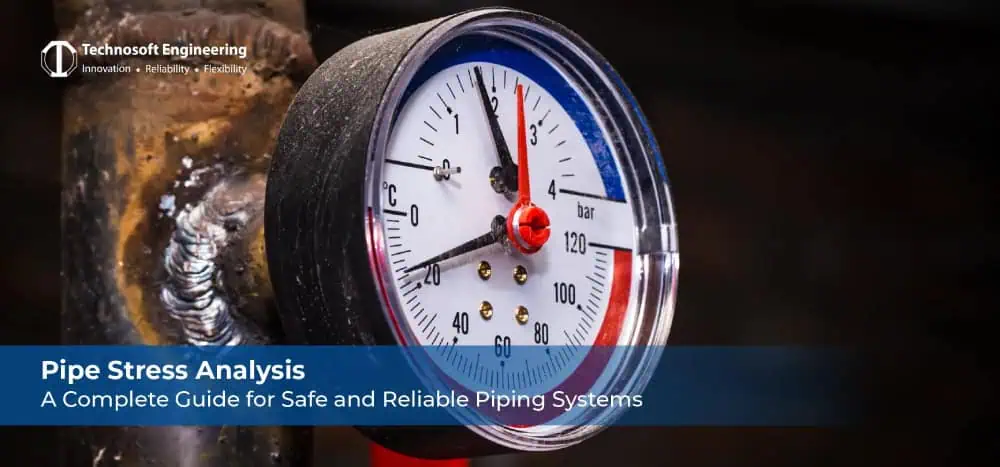
In big industries like oil & gas, chemical processing, and manufacturing, piping systems are the crucial backbone of the operations. These pipe networks are for transporting fluids, which have different temperatures, loads, etc.; therefore, the durability of these networks becomes essential. So to check the reliability of pipes, engineers perform pipe stress analysis, a method that checks how piping reacts when the operating conditions are changed.
If you have been wondering what pipe stress analysis is and why it is essential, this guide will walk you through its purpose, types of piping stresses, calculations, and its role in Plant Engineering Design.
What is Pipe Stress Analysis?
Pipe stress analysis, as said, is a technical process of evaluating the behavior of piping systems when exposed to internal and external forces. The main objective is to check that the system can safely handle stress caused by pressure, temperature changes, seismic activity, and operational loads.
Piper stress analysis sees some weak points before the consequences, such as leaks, ruptures, or any downtime. It is a very crucial step in engineering projects, especially in industries where safety and regulatory compliance are followed like a law.
Why is Pipe Stress Analysis Important?
Piping systems are exposed to a vast range of forces during their service life. Therefore, without the proper pipe stressing, all these forces can cause severe fatigue, cracking, or even catastrophic failure during operations. Therefore, these detailed checks assure:
- Safety – Prevents accidents because of material failure.
- Reliability – Extends the shelf life of the piping systems.
- Compliance – Meets industry standards and codes such as ASME and ISO.
- Cost Savings – Drops risks of downtime and unexpected repairs.
Types of Piping Stresses
To know pipe stress analysis in detail, it is essential to explore the types of piping stresses engineers evaluate:
Sustained Stress
- It is caused by the increase in internal pressure and the weight of the pipe, fluid, and insulation.
- All these are constant stresses that are observed during operations.
Expansion Stress
- It takes place during thermal expansion and contraction when temperatures change.
- If this is not managed, it can result in cracking of pipe joints.
Occasional Stress
- Results from occasional problems such as earthquakes, wind loads, or water hammer.
- These stresses are considered when designing the operations to ensure resilience during emergencies.
Pipe Stress Calculation
What is it, you may wonder? Well, pipe stress calculation quantifies the stresses that act on the piping systems. These calculations involve big formulas that account for:
- Pipe material and dimensions.
- Internal pressure and temperature.
- Outer loads such as wind or seismic forces.
- Support conditions and restraints.
Accurate pipe stress calculation makes sure that the pipes stay within the limits allowed for the stress defined by international design codes; therefore, providing safety.
The Process of Pipe Stressing
The real process of pipe stressing combines engineering principles, simulation tools, and design expertise. Which are:
- System Modeling – Engineers create a virtual model of the piping layout.
- Load Application – Operational loads, such as pressure, are applied to test.
- Stress Evaluation – Software calculates the total stress across the piping system.
- Design Changes – If stresses exceed limits, changes are made, such as adding supports, expansion joints, etc.
- Validation – Results are checked against industry standards before rolling out.
Pipe Stress Analysis in Plant Engineering Design
In Plant Engineering Design, the piping systems usually cover the whole facility, connecting equipment like pumps, compressors, heat exchangers, and reactors. Therefore, here the pipe stress analysis plays a key role in:
- Check compatibility between piping and connected systems.
- Reducing vibration and fatigue risks.
- Supporting plant efficiency via layouts that are optimized.
- Meeting safety standards in high-risk environments.
By applying pipe stress analysis during Plant Engineering Design, companies avoid the cost and time for redesigning.
Real-World Applications of Pipe Stress Analysis
Industries that heavily depend on pipe stress analysis are:
- Oil & Gas – To handle high-pressure pipelines and offshore systems.
- Power Generation – For steam pipelines and cooling water systems.
- Chemical Processing – To manage corrosive and high-temperature fluids.
- Cryogenics – Where extreme low temperatures cause significant contraction stresses.
Challenges in Pipe Stressing
Even though there are advances in software and materials, pipe stress analysis still faces several challenges, such as:
- Enhanced complex plant layouts.
- Natural calamities, earthquakes, or extreme weather.
- Use of new materials and technologies.
- Juggling safety with budget.
Resolving these problems needs not only technical expertise but also practical experience in industry.
Conclusion
So, what is pipe stress analysis, you asked? It is nothing but a systematic method to check whether the piping systems are running and operating smoothly. By categorizing stresses, engineers use pipe stress calculation and simulation techniques to optimize the designs.
The process of pipe stressing is essential in industries ranging from oil & gas to cryogenics, where failure can cause dangerous problems. When it is used in Plant Engineering Design, it offers long-term operational efficiency and reduced risks.
At Technosoft Engineering, we work on advanced pipe stress analysis and Plant Engineering Design solutions according to our clients’ needs. We have an experienced team that uses cutting-edge tools and profound expertise to make sure your piping systems are safe.
Contact us today to learn how we can optimize your next project with accuracy and reliability.